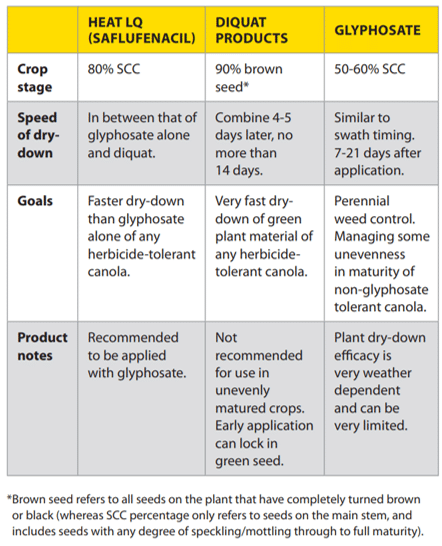What is the right pre-harvest product?
No product will speed up or even out crop maturation, but a pre-harvest aid can speed dry down (diquat products), control perennial weeds (glyphosate), or support crop and weed dry down (saflufenacil). Choosing the right pre-harvest aid depends on one’s goals, the field conditions and the weather forecast. Since timing is critical, ensure the intended products are in your spray shed now and double check Keep it Clean’s pre-harvest interval calculator and this pre-harvest glyphosate staging guide for canola. (Canola harvest guide)

Why are some plants prematuring, dead or weird?
Plants that mature quicker than the rest of the crop will be especially noticeable pre-swathing, providing the perfect scouting opportunity. Is it clubroot, blackleg, sclerotinia? Gather as much information as soon as possible: forensic agrology is best done before plants’ death and decay make diagnosis impossible. Address the few issues that are still within your control and keep thorough notes of what might impact a future crop: scouting results should be a key element in planning future rotations, variety choices and management decisions.
Aster yellows continues to appear – often with dramatic, ‘weird and wacky’ symptoms – but has so far remained at low incidence except in small regions in western Saskatchewan. Aster yellows cannot be prevented and there are no effective remedial treatments. If the issue is not disease, look for abiotic reasons. Volunteer canola can be heavily branched and may have different seed colour than the rest of the crop. (Disease ID tips for pre-harvest scouting)
When to swath?
Swathing will likely be earlier this year than in most years due to this season’s hot weather. To maximize yield and quality, canola should be swathed when at least 60% of seeds on the main stem (raceme) show some seed colour change (SCC). Note: seeds do not have to entirely change colour – seeds with any amount of mottling or speckling should be included in the SCC count. It typically takes canola 10-15 days to mature from the very first signs of SCC (approximately 40% moisture content) to 50-60% SCC (approximately 20% moisture content) under average August conditions. Pod colour is not a good indicator of seed colour change. (Canola harvest guide) (Canola swathing guide) (Assessing seed colour change)
How to assess maturity in uneven fields?
Uneven emergence and challenging growing conditions mean plant staging is patchy and/or variable in many fields. Maximizing profitability depends on accurately assessing maturity and determining where the majority of yield will be. Refer to the Canola Council of Canada’s Canola Swathing Guide for tips on how to assess an uneven field. (What to do with uneven fields) (Harvest management – timing, quality and yield)
